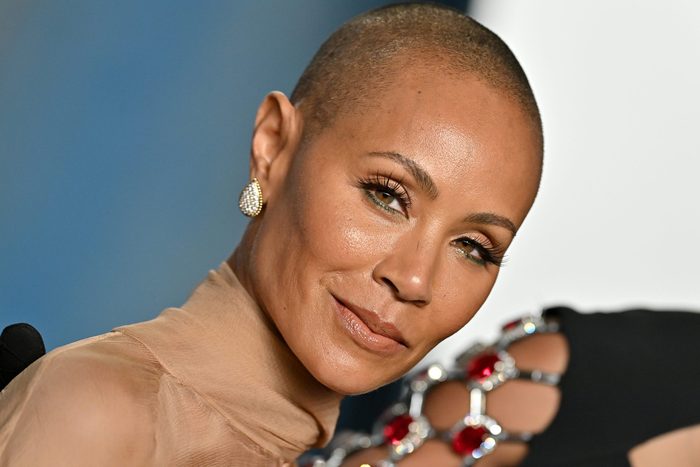
The Will Smith and Chris Rock encounter at the 2022 Oscars is a moment that’s generating quite a bit of buzz. Fortunately—of all the sides that are being argued across headlines and social media—the incident is highlighting one topic related to women’s wellness that hasn’t garnered quite the amount of attention it might deserve.
Reports today have suggested that Jada Pinkett Smith announced an alopecia diagnosis in 2018. Exactly what is alopecia? To start, it’s the clinical term for baldness, and it affects roughly 6.8 million people in the United States, according to Dr. Sanam Hafeez, Psy.D., a New York City neuropsychologist and a teaching faculty member at Columbia University.
Dr. Hafeez explains that alopecia areata is a common autoimmune disorder that often results in unpredictable hair loss from the head. (There are two other main types of alopecia—alopecia totalis, which is the loss of all head hair; and alopecia universalis, the loss of all head and body hair.) She suggests the condition can affect anyone, regardless of age and gender…but it’s not commonly known that 50 percent of women report some degree of hair thinning by age 50 says Jeffrey Miller, MD, Department of Dermatology chair at Penn State University’s Milton S. Hershey Medical Center. As Dr. Miller told the haircare brand Better Not Younger in 2018, “Hair loss and hair thinning are just as common among women as they are in men,” Dr. Miller says, “but it’s not socially acceptable for women to experience and deal with these.”
Dr. Hafeez says alopecia has been linked with depression and anxiety. For alopecia patients who have experienced psychological effects such as these, Dr. Hafeez suggests it’s important to keep things in perspective. She adds that while it’s valid to experience feelings of discomfort or embarrassment, keeping self-care central can help you keep your overall health in perspective. “Do and engage in things that make you feel beautiful and positive about yourself,” a representative for Dr. Hafeez said in an email to The Healthy.
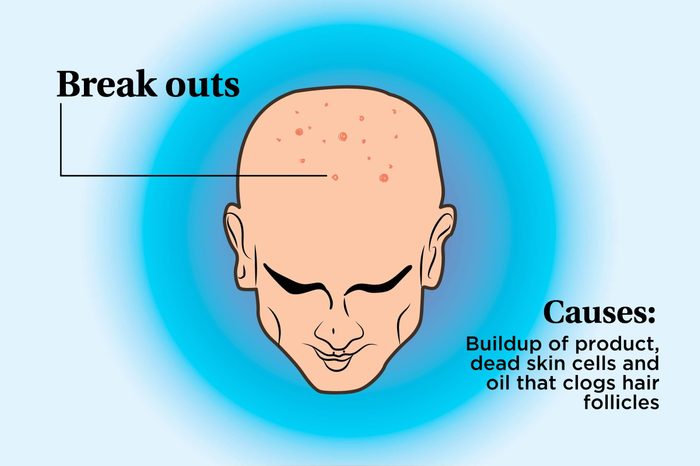
If you’re breaking out…
Thankfully, not all scalp conditions are noticeable to the people around you. It’s hard, for instance, to see any blemishes that appear on your scalp. However, that doesn’t mean they’re not there—or pesky and painful. “The main causes of scalp acne is the buildup of product, dead skin cells, and oil that clogs hair follicles,” explains Dendy Engelman, MD, a board-certified dermatologic surgeon in Manhattan and Hampton Bays, NY. “Bacterial growth can lead to breakouts if the scalp and hair are not being properly cleansed.” She suggests using a clarifying shampoo, such as REDKEN Hair Cleansing Cream Shampoo, at least once a week to regulate bacteria levels. Another solution is scalp-botox. This extends your blowout and can also help reduce oil production and possibly acne around your hairline.
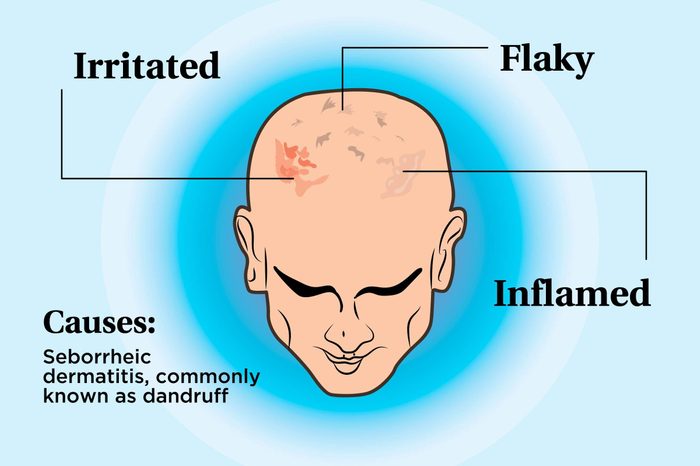
Your scalp is flaky, inflamed, and irritated…
If you’re experiencing white flakes on the scalp, you are likely suffering from seborrheic dermatitis. It’s one of the most common scalp conditions. You probably know it by its other name: dandruff. Consider improving the situation at home with these natural treatments for dandruff. “Yeast lives on everyone’s skin, but, in some people, it may promote inflammation,” explains Joshua Zeichner, MD, director of Cosmetic and Clinical Research in Dermatology at the Mount Sinai Hospital in New York City.
“This clinically looks like white flakes at the base of the hair around your scalp.” Dr. Zeichner suggests using medicated shampoos, such as Head and Shoulders, which contain an ingredient that helps lower yeast levels on the skin. By reducing the amount of yeast, you can lower inflammation and subsequently reduce the amount of flaking. (Be sure to check out how cold showers benefit your scalp health.)
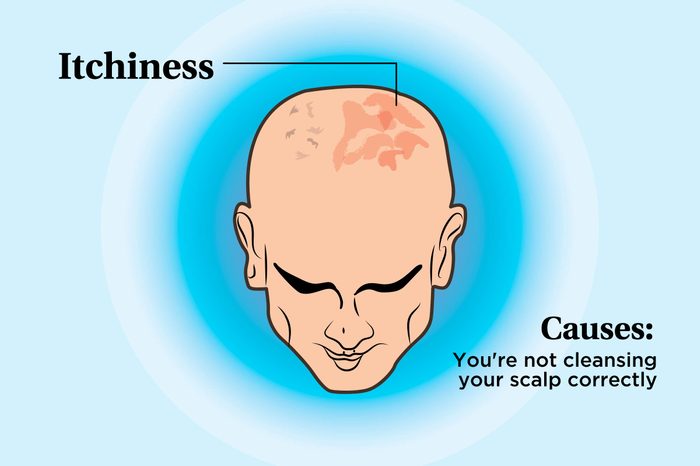
If you’re experiencing itchiness…
An itchy scalp can happen for a myriad of reasons. But if your itchiness is not accompanied by redness or flakiness, it’s likely because you’re not cleansing your scalp correctly. For this reason, Penny James, an International Association of Trichologists-certified trichologist and the owner of Penny James Salon in New York City, says it’s important to wash your hair and scalp at least four times a week. “The shampoos on the market these days are not as harsh as they were in previous decades, so look for a line of products that have active ingredients and botanical extracts and do not contain sulfates, silicones, or parabens.” For a dry scalp and hair, she suggests the all-natural and organic line, Aloida. These products work hard to nourish and hydrate the hair and scalp.
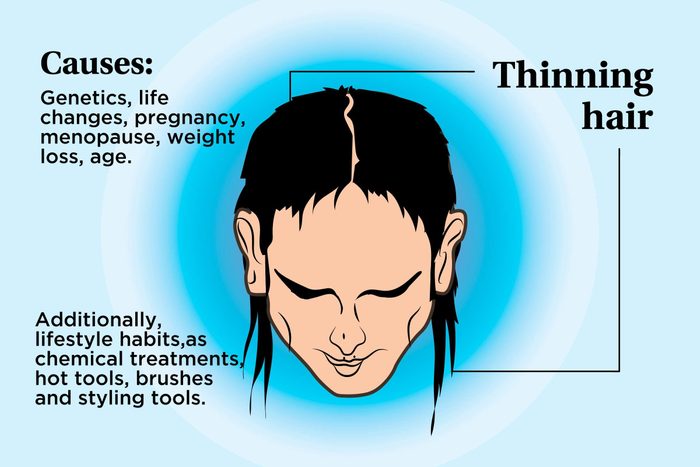
Your hair is thinning…
Genetics, as well as life changes, pregnancy, menopause, and weight loss, contribute to the interference of hair growth and other scalp conditions. So it is not uncommon for women to experience shedding at certain stages of life. “As we age, most hair is reduced either in the form of balding, receding, or thinning,” Dr. Engelman explains. “Additionally, lifestyle habits, including chemical treatments, hot tools, brushes, and other styling tools, can reduce or damage the hair.” She recommends oral supplements, such as protein, iron, zinc, and vitamin B12, to support hair follicles. “If you are not getting enough nutrients from your diet, supplements can increase low levels,” she says. “These nutrients help support hair structure, growth, and the breakdown of carbs and fats, and they moisturize the scalp and distribute oxygen to the cells.” Her go-to brands to combat hair thinning: Reserveage Keratin Booster and Nutrafol.

You’re seeing individual bald spots…
If you start noticing actual bald spots, this could be a sign that you have a condition called alopecia areata, says Dr. Zeichner. Interestingly, there are actually lots of sneaky reasons your hair is falling out. “In this condition, your immune system is getting angry at the hair-producing cells, which leads to specific bald spots,” explains Dr. Zeichner. “Visit your dermatologist for a full evaluation and professional treatment.” For some patients experiencing alopecia areata, their hair can be completely restored to normal.
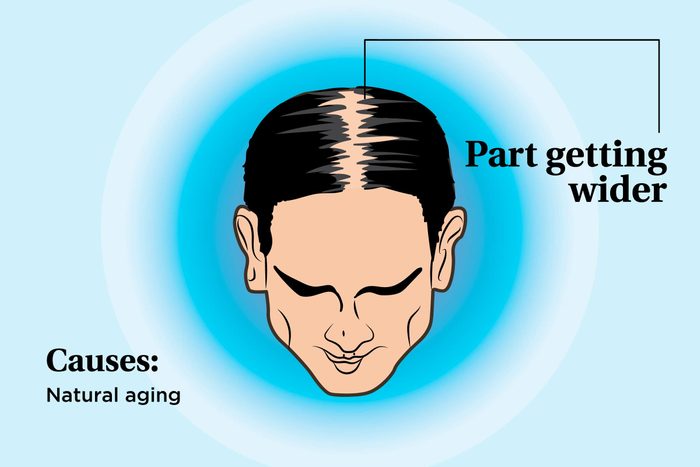
Your part is getting wider…
Another common side effect of aging—predominantly in women—involves changes in hair density along the frontal hairline. Typically, middle part widens. Dr. Zeichner suggests considering an over-the-counter product that helps promote healthy hair growth, such as évolis. “This hair product line decreases the activity of FGF5, a messenger involved in a hair growth cycle,” Dr. Zeichner explains. “Decreasing activity of FGF5 can help promote new hair growth and strengthen the hair you already have.” Another option is visiting your dermatologist to discuss a platelet-rich plasma treatment, which involves drawing blood and then separating the red blood cells from the serum. “The serum contains platelets, which have high levels of growth factors that are actually injected into the scalp in areas where you have hair thinning,” explains Dr. Zeichner. “This gives the hair follicles the nudge they need to behave like healthy follicle cells and rev up hair growth.”
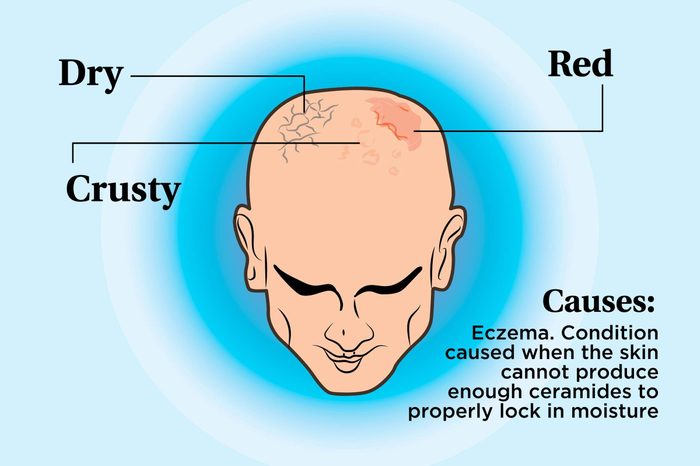
Your scalp is red, crusty, and dry…
If you’re noticing any areas of your scalp that are itchy and rough, you may have eczema (although there are several other reasons for your itchy scalp, too). It’s a common condition that can crop up on your entire body. “Eczema is caused when the skin cannot produce enough ceramides to properly lock in moisture,” explains Dr. Engelman. “The result is sensitive, itchy, and flaky skin.” Though eczema is a hereditary condition, there are ways to reduce the symptoms. Dr. Engelman recommends using fragrance-free shampoos and conditioners, trying not to scratch infected areas, and avoiding hot showers.
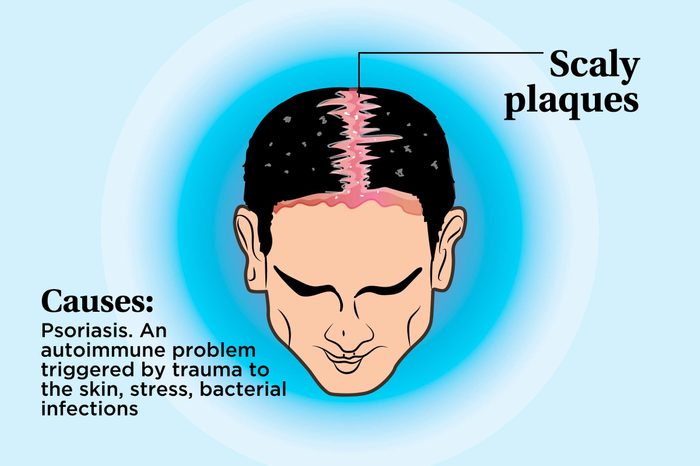
You’re feeling spots of scaly plaques…
Scaly plaques may mean psoriasis, an autoimmune problem possibly triggered by trauma to the skin, stress, bacterial infections, explains James. Unfortunately, there’s no cure for this condition. While treatment to relieve the symptoms varies from one person to another, James recommends using scalp lotions or creams that contain tar and salicylic acid, such as Neutrogena T/Gel Therapeutic Original Shampoo. “You can also try changing your diet,” she says. “Research shows that sometimes the elimination of gluten, yeast, wheat, and dairy produce is a possible contributing cause.” Ultimately, she suggests visiting your dermatologist. They can provide advanced treatments to keep this condition at bay. (Here’s how to tell the difference between scalp psoriasis vs. dandruff.)
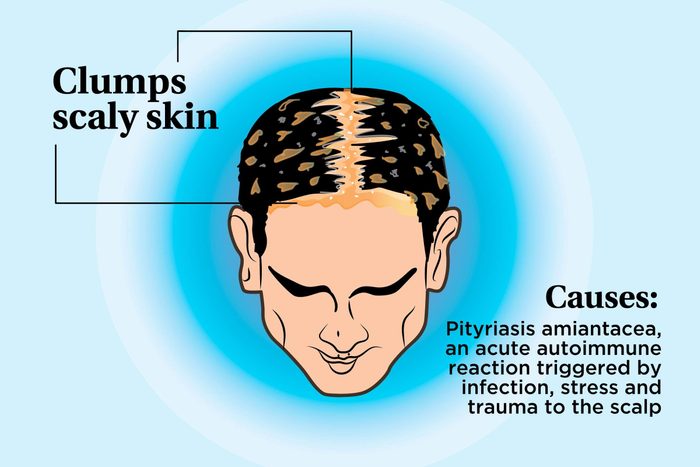
You’re experiencing clumps of scaly skin that are sticking to your hair…
Known as pityriasis amiantacea, these scaly clumps are an acute autoimmune reaction. Infection, stress, and scalp trauma may cause swelling, along with some redness or yellowing. Though it’s extremely unpleasant, James says that it’s easy to get rid of. First, ditch these 17 myths that are ruining your hair. She suggests giving your scalp a hot almond oil treatment. Afterward, use a treatment cream that contains salicylic acid and tar. Then, use a medicated shampoo on a daily basis until the condition is under control. “In very bad cases hair will fall out, but it will regrow,” she adds.
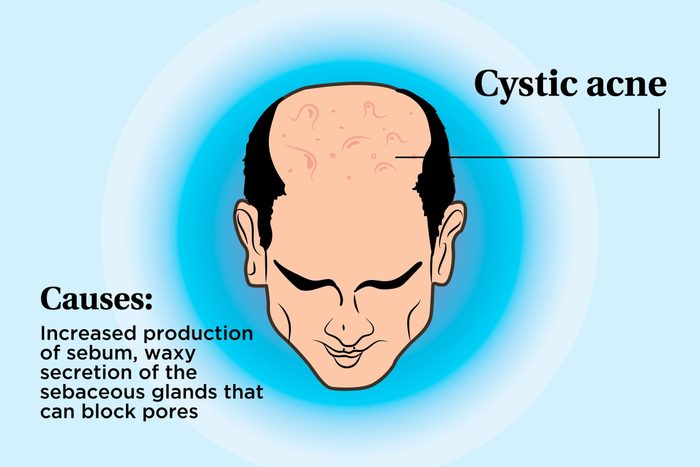
You’re dealing with cystic acne on your scalp…
Similarly to cystic acne on your face, experiencing it on your scalp is likely triggered by increased production of sebum, a waxy secretion of the sebaceous glands that can block pores. “The rate we produce sebum is genetically determined and influenced by the sex hormones and by thyroxine,” James explains. “It’s not influenced by the frequency of shampooing.” If you’re experiencing this, she suggests a visit to an IAT trichologist. “After a full scalp and hair analysis, a trichologist will be able to detect what is going on and determine the best treatment for your scalp,” she says. Until then, learn what your hair is trying to tell you about your health.
Keep reading:


